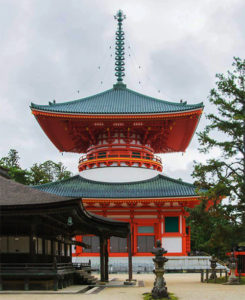

ここのところ仏教寺院建築研究に没入気味(笑)。
個人としてもそろそろ加齢からの仏心が芽生えてきたものか、
とは思うのですが、住宅の現代の姿を長年取材し続けてきて
結局、その住文化のマザーとして宗教建築表現に強く導かれるのでしょうか。
上の写真は千葉県佐倉市の歴史民俗博物館・根来寺大塔の模型展示。
日本は木造の国であり三内丸山、出雲大社などの「伝統」が根付いていた。
東アジア有数の海洋国家にして豊かな温暖島嶼国家。
ヒマラヤからの偏西風が東シナ海・日本海の水蒸気を受けて多雨気候になる。
結果として有数の森林資源に恵まれることになって、
建築素材形式としては石造ではなく木造がきわめて優勢の文化を育んだ。
そういう社会に統一国家形成のための精神的主柱として仏教思想が導入され
その宗教概念を表現する建築が多数建築された。
そのことが木造技術の発展にも相互反応しただろうことは容易にわかる。
木を使って多様なカタチを造作していくために研究・工夫が旺盛に盛り上がった。
多宝塔という日本独自の建築表現形式にはさまざまな条件が与っていたでしょう。
基本的なモチーフはストゥーパをどう制作するか、だったことは明らか。
ストゥーパは釈迦の遺体をお骨にして安置した建築が出自だった。
2枚目写真はインド中部に位置するサーンチー村、インド最古といわれる仏教遺跡。
インドを統一したアショーカ王(在位紀元前273~前232年頃)が
建てたストゥーパ(仏塔)がほぼ形を変えずに残されているという。
ストゥーパとはサンスクリット語で「高く顕れる」という意味であり、
仏教の世界観である涅槃の境地を象徴しているとされる。
建築目的はそうであってそれを表現するのにそれぞれの国・地域で多様化した。
原初的には円形ドーム形状、球体構造がイメージされたのでしょう。
インドでは乾燥気候を前提として石造りのドームとしたものが、
日本の多雨気候下では傘・屋根を頭に乗せ耐候性を高めたのが発想起点かと思える。

3枚目の写真は現在の高野山根本大塔。しかし現在の建物は1937年に
鉄筋コンクリートで再建されたもので建築史的正統性に疑問があり参考にならない。
空海が唐で見聞した寺院建築の基本思想に踏まえて「根本大塔」を企図したが
かれの時代にこの形式で建築されたかどうか不明で、むしろ後代の建築と思える。
写真を見ると基壇の上に建てられていて、根来寺の大塔とは足下にも違いがある。
空海の入定(835年)後、弟子であり実の甥でもあった真然が887年頃に
根本大塔などの伽藍を整備したというのが史実に近いと思われる。
しかし994年には落雷による火災のため、高野山はほとんどの伽藍を失っている。
高野山大塔はこういう経緯なので歴史民俗博物館では広く日本の建築史の視点から
根来寺の大塔を日本独自の多宝塔建築の代表と見なして展示しているのでしょう。
English version⬇
[Tahoto = Shakyamuni Stupa Kishu Negoroji-9]
Recently, I’ve been immersing myself in research on Buddhist temple architecture (laughs).
As an individual, it’s about time that the Buddha’s heart has sprung up from aging.
I think, but I’ve been covering the modern appearance of housing for many years.
After all, is it strongly guided by religious architectural expression as the mother of that living culture?
The photo above is a model exhibition of the Negoro-ji Temple, a museum of history and folk in Sakura City, Chiba Prefecture.
Japan is a wooden country, and “traditions” such as Sannai Maruyama and Izumo Taisha have taken root.
An affluent warm island nation that is one of the leading maritime nations in East Asia.
The westerlies from the Himalayas receive water vapor from the East China Sea and the Sea of Japan, resulting in a heavy rainfall climate.
As a result, we are blessed with one of the leading forest resources.
As a building material format, wooden construction rather than stone construction has fostered an extremely predominant culture.
Buddhist thought was introduced into such a society as a spiritual pillar for the formation of a unified nation.
Many buildings were built to express the religious concept.
It is easy to see that this would have reacted to the development of wooden technology.
There was a lot of research and ingenuity in order to create various shapes using wood.
Various conditions would have been given to Japan’s unique architectural expression form called the Tahoto.
It is clear that the basic motif was how to make a stupa.
The stupa originated from an architecture in which Buddha’s body was used as a bone.
The second photo is Sanchi village located in central India, the oldest Buddhist archaeological site in India.
King Ashoka (reigned 273 BC-232 BC) who unified India
It is said that the stupa (stupa) that was built remains almost unchanged.
Stupa is a Sanskrit word meaning “highly visible.”
It is said to symbolize the state of Nirvana, which is the world view of Buddhism.
The purpose of architecture is so, and to express it, it has diversified in each country / region.
Originally, the image was a circular dome shape and a spherical structure.
In India, a stone dome is used on the premise of a dry climate.
Under the heavy rain climate in Japan, it seems that the idea was to put an umbrella / roof on the head to improve the weather resistance.
The third photo is the current Koyasan Konpon Daito. But the current building was in 1937
It was reconstructed with reinforced concrete and has doubts about the legitimacy of architectural history, so it is not helpful.
Based on the basic idea of temple architecture that Kukai saw in Tang, he planned “Konpon Daito”.
It is unclear whether he was built in this form in his time, rather it seems to be a later generation.
Looking at the photo, it is built on the platform, and there is a difference in the feet from the main tower of Negoroji Temple.
After Kukai’s appointment (835), Shinzen, who was his disciple and nephew, was around 887.
It seems to be close to historical fact that he maintained the temples such as Konpon Daito.
However, in 994, Koyasan lost most of its cathedral due to a fire caused by a lightning strike.
Because of this background, Koyasan Oto is widely used in the History and Folklore Museum from the perspective of Japanese architectural history.
The large tower of Negoroji Temple is probably exhibited as a representative of Japan’s unique Tahoto architecture.
Posted on 11月 22nd, 2021 by 三木 奎吾
Filed under: 住宅マーケティング, 日本社会・文化研究, 歴史探訪







コメントを投稿
「※誹謗中傷や、悪意のある書き込み、営利目的などのコメントを防ぐために、投稿された全てのコメントは一時的に保留されますのでご了承ください。」
You must be logged in to post a comment.